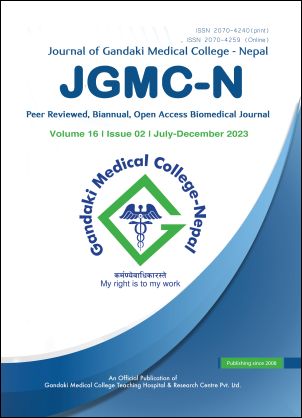Prescription pattern of antibiotics in urinary tract infection based on antimicrobial susceptibility test at a tertiary care hospital
DOI:
https://doi.org/10.3126/jgmcn.v16i2.60725Keywords:
AST, empirical, gram negative, gram positive, UTIAbstract
Introduction: Urinary tract infection is a common bacterial infection associated with significant morbidity, mortality, and financial burden. This study aimed to identify the causative bacteria, assess their antimicrobial susceptibility patterns and evaluate empirical and definitive antibiotic therapy for urinary tract infection.
Methods: A hospital-based crosssectional study was conducted at the outpatient medicine department at a teaching hospital in Nepal from February 15 to July 14, 2022. Two hundred participants with positive urine cultures and antimicrobial susceptibility testing were included. The microorganism causing urinary tract infection and prescription pattern of antibiotics pre-and post-AST report were analyzed.
Results: The majority of isolated pathogens were gram-negative bacteria (73%), with Escherichia coli being the most common (53.5%), followed by Staphylococcus aureus among gram-positive bacteria (14.5%). Female patients had a higher incidence of urinary tract infection (59.5%) than males (40.5%). The age group above 60 years had the highest occurrence (34%). Antibiotic susceptibility testing revealed that Escherechia coli exhibited higher sensitivity to nitrofurantoin, amikacin, and meropenem, while resistance was observed against ampicillin, cefixime, and norfloxacin. Empirical antibiotics were commonly prescribed, with levofloxacin and ceftriaxone being the most frequent choices. After antibiotic susceptibility testing, nitrofurantoin and levofloxacin were frequently prescribed.
Conclusions: This study provides valuable insights into the etiology of urinary tract infection and antibiotic susceptibility patterns, aiding in selecting appropriate antimicrobial therapy based on local resistance patterns.
Downloads
Downloads
Published
How to Cite
Issue
Section
License
Copyright (c) 2023 Laxmi Shrestha, Shristi Adhikari, Anjan Palikhey, Buddhi Raj Pokhrel , Amit Kumar Shrivastava , Bishal Joshi, Chandrajeet Kumar Yadav

This work is licensed under a Creative Commons Attribution-NonCommercial 4.0 International License.
This license allows reusers to distribute, remix, adapt, and build upon the material in any medium or format for noncommercial purposes only, and only so long as attribution is given to the creator.




